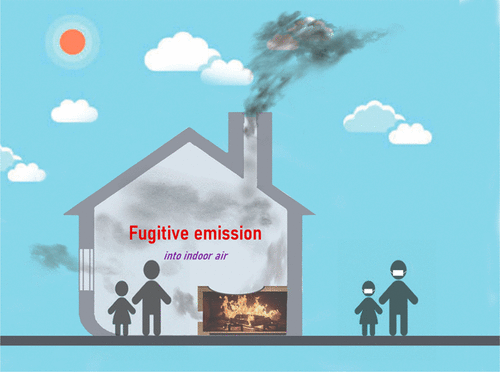当前位置:
X-MOL 学术
›
Environ. Sci. Technol. Lett.
›
论文详情
Our official English website, www.x-mol.net, welcomes your
feedback! (Note: you will need to create a separate account there.)
Fugitive Emissions of CO and PM2.5 from Indoor Biomass Burning in Chimney Stoves Based on a Newly Developed Carbon Balance Approach
Environmental Science & Technology Letters ( IF 8.9 ) Pub Date : 2020-02-13 , DOI: 10.1021/acs.estlett.0c00095 Guofeng Shen 1 , Wei Du 2 , Zhihan Luo 1 , Yaojie Li 1 , Guoshuai Cai 1 , Cengxi Lu 1 , Youwei Qiu 1 , Yuanchen Chen 3 , Hefa Cheng 1 , Shu Tao 1
Environmental Science & Technology Letters ( IF 8.9 ) Pub Date : 2020-02-13 , DOI: 10.1021/acs.estlett.0c00095 Guofeng Shen 1 , Wei Du 2 , Zhihan Luo 1 , Yaojie Li 1 , Guoshuai Cai 1 , Cengxi Lu 1 , Youwei Qiu 1 , Yuanchen Chen 3 , Hefa Cheng 1 , Shu Tao 1
Affiliation

|
Fugitive emissions of smoke from stoves directly affect indoor air quality. However, this important process has been very scarcely evaluated so far. In this study, a novel approach has been developed to quantify fugitive emissions in the field, and for the first time, field-based fugitive emission factors (EFs) and fugitive fractions of carbon monoxide (FCO) and fine particulate matter (PM2.5) (FPM2.5) from indoor biomass burning in the real world are reported. Fugitive EFs were more likely log-normally distributed and positively correlated to the stack and total EFs. The calculated FCO and FPM2.5 were 13.5 ± 10.3% and 27.9 ± 13.7%, respectively, which were higher than those determined in laboratory studies. Fugitive fractions were normally distributed, and the mean FPM2.5 was close to the assumed value of 25% in the World Health Organization Guidelines for Indoor Air Quality: Household Fuel Combustion; however, the FCO was significantly lower than 25%. The total EFs calculated on the basis of the traditional carbon mass balance method were positively correlated with the total summarized from fugitive and stack emissions but were considerably underestimated, especially for PM2.5, as the mixing ratio of PM2.5 to carbon dioxide in fugitive emissions was found to be higher than that in the chimney exhaust.
中文翻译:

基于新开发的碳平衡方法的烟囱炉膛室内生物质燃烧过程中CO和PM 2.5的逸散排放
炉灶产生的烟雾散逸性直接影响室内空气质量。但是,到目前为止,几乎没有对这一重要过程进行评估。在这项研究中,已开发出一种新颖的方法来量化现场的逃逸排放,并且首次基于现场的逃逸排放因子(EFs)和一氧化碳(F CO)和细颗粒物(PM 2.5)(F PM 2.5)来自现实世界中室内生物质燃烧的报告。逃逸EF更有可能呈对数正态分布,并且与堆栈和总EF呈正相关。计算出的F CO和F PM 2.5分别为13.5±10.3%和27.9±13.7%,高于实验室研究中确定的值。逸散分数呈正态分布,平均 F PM 2.5接近世界卫生组织《室内空气质量指南:家庭燃料燃烧》中假定的25%的值。但是,F CO明显低于25%。基于传统碳质量平衡方法计算的总EF与逃逸烟囱排放和烟囱排放汇总的总排放呈正相关,但由于PM 2.5的混合比而被低估了,尤其是对于PM 2.5 发现短时排放中的二氧化碳比烟囱尾气中的高。
更新日期:2020-02-13
中文翻译:

基于新开发的碳平衡方法的烟囱炉膛室内生物质燃烧过程中CO和PM 2.5的逸散排放
炉灶产生的烟雾散逸性直接影响室内空气质量。但是,到目前为止,几乎没有对这一重要过程进行评估。在这项研究中,已开发出一种新颖的方法来量化现场的逃逸排放,并且首次基于现场的逃逸排放因子(EFs)和一氧化碳(F CO)和细颗粒物(PM 2.5)(F PM 2.5)来自现实世界中室内生物质燃烧的报告。逃逸EF更有可能呈对数正态分布,并且与堆栈和总EF呈正相关。计算出的F CO和F PM 2.5分别为13.5±10.3%和27.9±13.7%,高于实验室研究中确定的值。逸散分数呈正态分布,平均 F PM 2.5接近世界卫生组织《室内空气质量指南:家庭燃料燃烧》中假定的25%的值。但是,F CO明显低于25%。基于传统碳质量平衡方法计算的总EF与逃逸烟囱排放和烟囱排放汇总的总排放呈正相关,但由于PM 2.5的混合比而被低估了,尤其是对于PM 2.5 发现短时排放中的二氧化碳比烟囱尾气中的高。









































 京公网安备 11010802027423号
京公网安备 11010802027423号